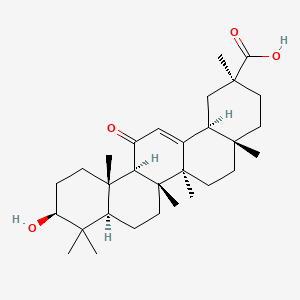| Authors | Title | Published | Journal | PubMed Link |
|---|---|---|---|---|
| Kuang P et al. | 18β-glycyrrhetinic acid inhibits hepatocellular carcinoma development by reversing hepatic stellate cell-mediated immunosuppression in mice. | 2013 | Int. J. Cancer | pmid:22991231 |
| Shetty AV et al. | 18α-glycyrrhetinic acid targets prostate cancer cells by down-regulating inflammation-related genes. | 2011 | Int. J. Oncol. | pmid:21637916 |
| Kuzma-Kuzniarska M et al. | Functional assessment of gap junctions in monolayer and three-dimensional cultures of human tendon cells using fluorescence recovery after photobleaching. | 2014 | J Biomed Opt | pmid:24390370 |
| Zong L et al. | 18α-glycyrrhetinic acid extracted from Glycyrrhiza radix inhibits proliferation and promotes apoptosis of the hepatic stellate cell line. | 2013 | J Dig Dis | pmid:23362936 |
| Feng Yeh C et al. | Water extract of licorice had anti-viral activity against human respiratory syncytial virus in human respiratory tract cell lines. | 2013 | J Ethnopharmacol | pmid:23643542 |
| Fu XX et al. | 18β-Glycyrrhetinic acid potently inhibits Kv1.3 potassium channels and T cell activation in human Jurkat T cells. | 2013 | J Ethnopharmacol | pmid:23707333 |
| Kao TC et al. | Glycyrrhizic acid and 18beta-glycyrrhetinic acid inhibit inflammation via PI3K/Akt/GSK3beta signaling and glucocorticoid receptor activation. | 2010 | J. Agric. Food Chem. | pmid:20681651 |
| Wang CY et al. | Glycyrrhizic acid and 18β-glycyrrhetinic acid modulate lipopolysaccharide-induced inflammatory response by suppression of NF-κB through PI3K p110δ and p110γ inhibitions. | 2011 | J. Agric. Food Chem. | pmid:21644799 |
| Kao TC et al. | Neuroprotective effects of glycyrrhizic acid and 18beta-glycyrrhetinic acid in PC12 cells via modulation of the PI3K/Akt pathway. | 2009 | J. Agric. Food Chem. | pmid:19105645 |
| Yamada A et al. | Connexin 43 Is Necessary for Salivary Gland Branching Morphogenesis and FGF10-induced ERK1/2 Phosphorylation. | 2016 | J. Biol. Chem. | pmid:26565022 |
| Gumpricht E et al. | Licorice compounds glycyrrhizin and 18beta-glycyrrhetinic acid are potent modulators of bile acid-induced cytotoxicity in rat hepatocytes. | 2005 | J. Biol. Chem. | pmid:15642733 |
| Xiao Y et al. | 18Beta-glycyrrhetinic acid ameliorates acute Propionibacterium acnes-induced liver injury through inhibition of macrophage inflammatory protein-1alpha. | 2010 | J. Biol. Chem. | pmid:19897483 |
| Kapeta S et al. | Nuclear erythroid factor 2-mediated proteasome activation delays senescence in human fibroblasts. | 2010 | J. Biol. Chem. | pmid:20068043 |
| Romanello M and D'Andrea P | Dual mechanism of intercellular communication in HOBIT osteoblastic cells: a role for gap-junctional hemichannels. | 2001 | J. Bone Miner. Res. | pmid:11499869 |
| Boengler K et al. | Mitochondrial connexin 43 impacts on respiratory complex I activity and mitochondrial oxygen consumption. | 2012 | J. Cell. Mol. Med. | pmid:22212640 |
| Zhang W et al. | Bone morphogenetic protein-2 modulation of chondrogenic differentiation in vitro involves gap junction-mediated intercellular communication. | 2002 | J. Cell. Physiol. | pmid:12385001 |
| Sharma G et al. | 18β-glycyrrhetinic acid induces apoptosis through modulation of Akt/FOXO3a/Bim pathway in human breast cancer MCF-7 cells. | 2012 | J. Cell. Physiol. | pmid:21732363 |
| Queiroga CS et al. | Paracrine effect of carbon monoxide - astrocytes promote neuroprotection through purinergic signaling in mice. | 2016 | J. Cell. Sci. | pmid:27383770 |
| El-Sabban ME et al. | ECM-induced gap junctional communication enhances mammary epithelial cell differentiation. | 2003 | J. Cell. Sci. | pmid:12893812 |
| Kato R et al. | Gap-junction-mediated communication in human periodontal ligament cells. | 2013 | J. Dent. Res. | pmid:23677649 |
18alpha-glycyrrhetinic acid
18alpha-glycyrrhetinic acid is a lipid of Prenol Lipids (PR) class. 18alpha-glycyrrhetinic acid is associated with abnormalities such as Wiskott-Aldrich Syndrome. The involved functions are known as inhibitors, salivary gland development and branching morphogenesis.
Cross Reference
Introduction
To understand associated biological information of 18alpha-glycyrrhetinic acid, we collected biological information of abnormalities, associated pathways, cellular/molecular locations, biological functions, related genes/proteins, lipids and common seen animal/experimental models with organized paragraphs from literatures.
What diseases are associated with 18alpha-glycyrrhetinic acid?
18alpha-glycyrrhetinic acid is suspected in and other diseases in descending order of the highest number of associated sentences.
Related references are mostly published in these journals:
| Disease | Cross reference | Weighted score | Related literature |
|---|
No disease MeSH terms mapped to the current reference collection.
PubChem Associated disorders and diseases
What pathways are associated with 18alpha-glycyrrhetinic acid
There are no associated biomedical information in the current reference collection.
PubChem Biomolecular Interactions and Pathways
Link to PubChem Biomolecular Interactions and PathwaysWhat cellular locations are associated with 18alpha-glycyrrhetinic acid?
There are no associated biomedical information in the current reference collection.
What functions are associated with 18alpha-glycyrrhetinic acid?
Related references are published most in these journals:
| Function | Cross reference | Weighted score | Related literatures |
|---|
What lipids are associated with 18alpha-glycyrrhetinic acid?
There are no associated biomedical information in the current reference collection.
What genes are associated with 18alpha-glycyrrhetinic acid?
There are no associated biomedical information in the current reference collection.
What common seen animal models are associated with 18alpha-glycyrrhetinic acid?
There are no associated biomedical information in the current reference collection.
